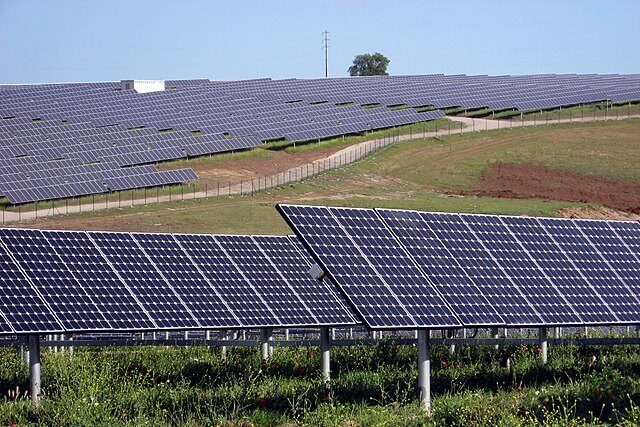
Conservationists have warned that large-scale solar farm developments could drive rare wildlife habitats “beyond the point of no return”.
According to Gwent Wildlife Trust, Llanwern Solar Farm – one of the UK’s largest solar farms, constructed across two Sites of Special Scientific Interest (SSSIs) – has been linked to declines in bird, bat and insect populations.
Supporters of solar power argue that such developments help to cut household bills, create jobs, strengthen energy security and address climate change.
Government figures show that more than 1,000 solar farms are currently in operation across the UK, with a further 800 granted planning permission. The operator of Llanwern Solar Farm has been approached for comment.
Built in 2020, Llanwern Solar Farm lies on the Gwent Levels, a protected network of reens and ditches in south-east Wales dating back to Roman times. Covering an area equivalent to around 100 rugby pitches, it is capable of supplying electricity to more than 20,000 homes.
Natalie Buttriss, chief executive of Gwent Wildlife Trust, said local wildlife numbers have fallen since the site was developed.
“It’s a Site of Special Scientific Interest (SSSI) – and the clue is in the name, it’s special for both people and wildlife,” she said.
“Lapwings weren’t returning to the site to breed and they’re very rare now as a species in the levels.
“We [also] found that bat populations were crashing – the insect mass has gone down,” she added.
A Welsh government report published last year linked the solar farm to:
-
A decline in the local Lapwing population.
-
A significant drop in brown-banded and shrill carder bee numbers.
-
Only one bat box being occupied during monitoring.
The Trust expressed concern over several larger solar farm proposals for the Gwent Levels.
While Ms Buttriss said she is not opposed to solar energy in principle, she warned that building further sites on protected land could “open the floodgates” for similar developments nationwide.
“It will be cumulative, one solar farm on its own would be devastating enough for the special landscape we’ve got here,” she said.
“But yes, if you accumulate more and more solar farms, that’s going to have a bigger impact – species will not be able to spread and disperse – and find breeding places and places to feed,” she said.
“All of that is going to come crashing down if we start to go beyond the point of no return.”
A Senedd petition opposing the new proposals has so far attracted nearly 6,000 signatures.
The Welsh government said, “pilot planning guidance for the Gwent Levels is currently being prepared”.
The Welsh government has confirmed that “pilot planning guidance for the Gwent Levels is currently being prepared”.
The debate reflects wider tensions across the UK regarding solar development.
On Anglesey, for example, the recently approved Alaw Môn solar farm – more than twice the size of Llanwern – could provide power for every household on the island. However, some residents have raised concerns about the loss of farmland.
Professor Dave Chadwick, of Bangor University, who has studied the impact of solar farms on land use, said disputes over renewable energy schemes were part of a broader debate about how best to use Britain’s limited land resources.
While some conservation groups remain critical, advocates argue that solar farms can also benefit biodiversity.
“We haven’t got any more land, we can’t create it, yet we need our land to provide food security, to contribute to energy security, to deliver our clean water and clean air, and our biodiversity,” he said.
“So it’s about coming up with a good, regional, national, land use optimisation strategy, which will allow us to understand how we’re going to use land to deliver these different services.
“There’s no black and white rule here, it’s not an easy thing to try and work out,” he said.
Chris Hewett, chief executive of Solar Energy UK, said the organisation’s annual Solar Habitat report shows that solar farms can be “absolute boons for nature”.
“We are starting to see clear benefits for biodiversity, with over 50% of sites seeing red-listed birds, such as nightingale, linnet and yellowhammer,” he added.
Proponents also point to economic and environmental benefits, including lower bills, job creation, greater energy security and reduced carbon emissions.
The UK government estimates that the solar sector could support 35,000 jobs by 2030, while the Welsh government has set a target of generating 70% of its electricity from renewable sources by the same year.
Dan McCallum, who runs Awel Aman Tawe in Carmarthenshire – an organisation that develops solar projects – believes scale is important.
“The bigger the better,” he said.
“If we could develop a massive solar farm here we would, but there’s simply not the land,” he said.
“The public debate has got to catch up and recognise it’s a global industry, and we need to move on.
“With a bigger solar farm, it’s more efficient, the costs come down – it’s much cheaper to make a larger solar farm than a smaller solar farm.”
He acknowledged that schemes on protected sites must be carefully assessed through the planning system.
“I think climate change is having a much bigger impact on biodiversity, and I think organisations like the wildlife trust need to recognise that,” he added.
A UK government spokesperson added that climate change, rather than renewable development, represents the “biggest long-term threat” to nature.
“Delivering more solar goes hand-in-hand with our work to reverse the decline of nature, after years of neglect – having been found to treble bird numbers and increase bumblebee populations.
“Families in Wales have seen their energy bills go through the roof due to our exposure to fossil fuels and delivering clean power, like solar, is how we help get bills down for good and make Britain more energy secure.”
The Welsh government said: “There are currently a number of solar farm applications for the Gwent Levels that are being determined as Developments of National Significance.
“It would therefore be inappropriate to comment further on specific proposals due to the Welsh ministers’ role in the decision-making process.”
——————————————————————————
At Natural World Fund, we are passionate about restoring habitats in the UK to halt the decline in our wildlife.

